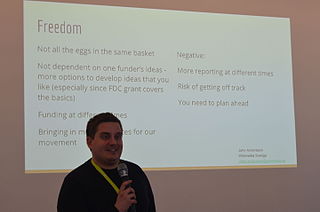Related Research Articles

Online chat may refer to any kind of communication over the Internet that offers a real-time transmission of text messages from sender to receiver. Chat messages are generally short in order to enable other participants to respond quickly. Thereby, a feeling similar to a spoken conversation is created, which distinguishes chatting from other text-based online communication forms such as Internet forums and email. Online chat may address point-to-point communications as well as multicast communications from one sender to many receivers and voice and video chat, or may be a feature of a web conferencing service.
Social software, also known as social apps or social platform includes communications and interactive tools that are often based on the Internet. Communication tools typically handle capturing, storing and presenting communication, usually written but increasingly including audio and video as well. Interactive tools handle mediated interactions between a pair or group of users. They focus on establishing and maintaining a connection among users, facilitating the mechanics of conversation and talk. Social software generally refers to software that makes collaborative behaviour, the organisation and moulding of communities, self-expression, social interaction and feedback possible for individuals. Another element of the existing definition of social software is that it allows for the structured mediation of opinion between people, in a centralized or self-regulating manner. The most improved area for social software is that Web 2.0 applications can all promote co-operation between people and the creation of online communities more than ever before. The opportunities offered by social software are instant connections and opportunities to learn.An additional defining feature of social software is that apart from interaction and collaboration, it aggregates the collective behaviour of its users, allowing not only crowds to learn from an individual but individuals to learn from the crowds as well. Hence, the interactions enabled by social software can be one-to-one, one-to-many, or many-to-many.
Telepresence refers to a set of technologies which allow a person to feel as if they were present, to give the appearance or effect of being present via telerobotics, at a place other than their true location.
The social web is a set of social relations that link people through the World Wide Web. The social web encompasses how websites and software are designed and developed in order to support and foster social interaction. These online social interactions form the basis of much online activity including online shopping, education, gaming and social networking services. The social aspect of Web 2.0 communication has been to facilitate interaction between people with similar tastes. These tastes vary depending on who the target audience is, and what they are looking for. For individuals working in the public relation department, the job is consistently changing and the impact is coming from the social web. The influence held by the social network is large and ever changing.

Web conferencing is used as an umbrella term for various types of online conferencing and collaborative services including webinars, webcasts, and web meetings. Sometimes it may be used also in the more narrow sense of the peer-level web meeting context, in an attempt to disambiguate it from the other types known as collaborative sessions. The terminology related to these technologies is exact and agreed relying on the standards for web conferencing but specific organizations practices in usage exist to provide also term usage reference.
Backchannel is the use of networked computers to maintain a real-time online conversation alongside the primary group activity or live spoken remarks. The term was coined from the linguistics term to describe listeners' behaviours during verbal communication.

Videotelephony is the two-way or multipoint reception and transmission of audio and video signals by people in different locations for real-time communication. A videophone is a telephone with a video camera and video display, capable of simultaneous video and audio communication. Videoconferencing implies the use of this technology for a group or organizational meeting rather than for individuals, in a videoconference. Telepresence may refer either to a high-quality videotelephony system or to meetup technology, which can go beyond video into robotics. Videoconferencing has also been called visual collaboration and is a type of groupware.

An academic conference or scientific conference is an event for researchers to present and discuss their scholarly work. Together with academic or scientific journals and preprint archives, conferences provide an important channel for exchange of information between researchers. Further benefits of participating in academic conferences include learning effects in terms of presentation skills and “academic habitus”, receiving feedback from peers for one's own research, the possibility to engage in informal communication with peers about work opportunities and collaborations, and getting an overview of current research in one or more disciplines.

The Internet Governance Forum (IGF) is a multistakeholder governance group for policy dialogue on issues of Internet governance. It brings together all stakeholders in the Internet governance debate, whether they represent governments, the private sector or civil society, including the technical and academic community, on an equal basis and through an open and inclusive process. The establishment of the IGF was formally announced by the United Nations Secretary-General in July 2006. It was first convened in October–November 2006 and has held an annual meeting since then.

An unconference is a participant-driven meeting. The term "unconference" has been applied, or self-applied, to a wide range of gatherings that try to avoid hierarchical aspects of a conventional conference, such as sponsored presentations and top-down organization.
Mobile dating services, also known as cell dating, cellular dating, or cell phone dating, allow individuals to chat, flirt, meet, and possibly become romantically involved by means of text messaging, mobile chatting, and the mobile web.

This is a comparison of standards of wireless networking technologies for devices such as mobile phones. A new generation of cellular standards has appeared approximately every tenth year since 1G systems were introduced in 1979 and the early to mid-1980s.

Institutional Web Management Workshop (IWMW) is a series of workshop events which was originally organised by UKOLN to provide professional development for web managers, policy makers, developers, designers and information professionals related to the UK's higher education community. Following cessation of JISC's core funding for UKOLN, since 2014 the event has been organised by UK Web Focus.

Marc Scarpa is an American entrepreneur, producer and director specializing in live participatory media. He is the executive board member and the founding New York Chair of the Producers Guild of America New Media Council and a recipient of the Marc A. Levey distinguished service award. Scarpa has received a Webby Award in 2010 for Best Event / Live Webcast for his work on the 52nd Annual Grammy Awards, a Cannes Bronze Lion for Branded Content and Entertainment for the X Factor Pepsi Digital Preshow and Xtra Factor App and four Social TV Awards including Best of Show for X Factor Pepsi Digital Preshow and Xtra Factor App. Additionally, he has been a panelist for conferences such as NATPE, X-Summit, LTE North America, Digital Hollywood and Canadian Music Week among others.
Synchronous conferencing is the formal term used in computing, in particular in computer-mediated communication, collaboration and learning, to describe technologies informally known as online chat. It is sometimes extended to include audio/video conferencing or instant messaging systems that provide a text-based multi-user chat function. The word synchronous is used to qualify the conferencing as real-time, as distinct from a system such as e-mail, where messages are left and answered later.

A lightning talk is a very short presentation lasting only a few minutes, given at a conference or similar forum. Several lightning talks will usually be delivered by different speakers in a single session, sometimes called a data blitz.

Microsoft Ignite is an annual conference for developers and IT professionals hosted by Microsoft. It has taken place in several locations around the world. The first conference, then known as TechEd, happened in 1993 in Orlando, Florida, United States. The 2014 TechEd in Barcelona marked the last event using that name. Microsoft altered its conference schedule and introduced the Microsoft Ignite name from 2015 on.

A hybrid event is a tradeshow, conference, unconference, seminar, workshop or other meeting that combines a "live" in-person event with a "virtual" online component.
A second screen involves the use of a computing device to provide a different viewing experience for content on another device.

Android Developer Days (ADD) is an open conference held at various locations worldwide each year. The Android Developer Days conference is a growing organization that allows developers of various software and applications to showcase, observe, and participate in Android Developing events, such as informational lectures, workshops, entertainment activities, panel discussions, and networking opportunities make up a majority of the Android Developer Days. As an international leader in mobile operating systems, ADD has become increasingly popular as the center for mobile device conventions. Unofficial participants may elect to observe different booths and displays. However, in order to partake in the festivities, one must apply to join the organization. There is an assortment of ways that one is able to join the conference including exhibiting your own presentation, showcasing posters featuring developing applications, or instructing hands-on, interactive coding tutorials. In 2014, the Android Developer Days conventions had been held in Ankara, Turkey, from May 16 to May 17.
References
- ↑ Dempsey, Lorcan (July 25, 2007). "The amplified conference" . Retrieved 2008-08-30.
- ↑ Wankel, Charles (18 January 2011). Higher Education Administration with Social Media. ISBN 978-0857246516.
- ↑ Haider, Jutta; Huvila, Isto; Cox, Andrew; Francke, Helena; Hall, Hazel (24 January 2013). "Transformation or continuity?: The impact of social media on information: implications for theory and practice". Proceedings of the American Society for Information Science and Technology. Wiley. 49 (1): 1–4. doi: 10.1002/meet.14504901101 . ISSN 0044-7870.
- ↑ Guy, Marieke (January 30, 2011). "10 Cheap and Easy Ways to Amplify Your Event" . Retrieved 2012-04-04.
- ↑ Shabajee, Paul (August 1, 2003). "'Hot' or Not? Welcome to real-time peer review" . Retrieved 2008-08-30.